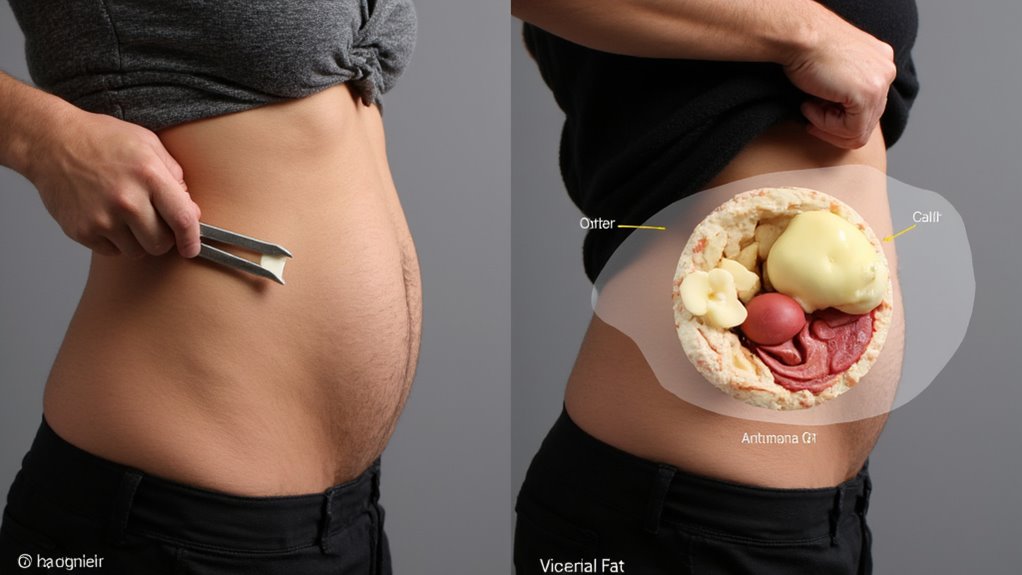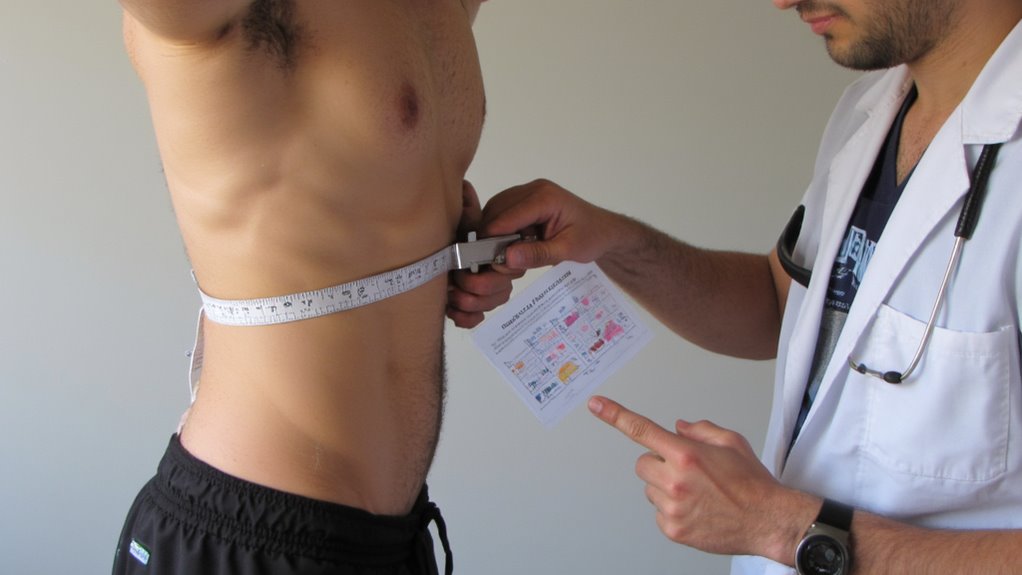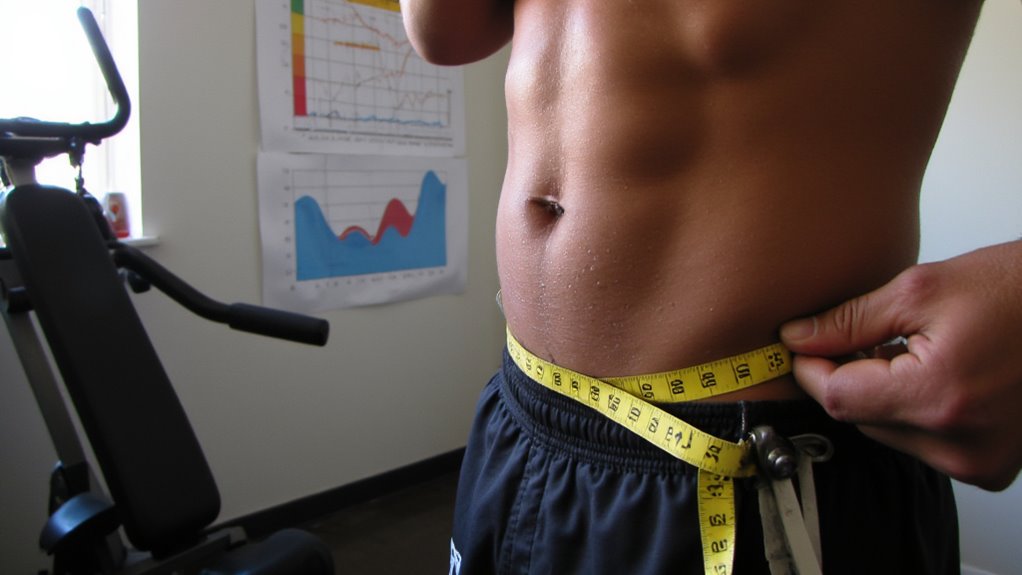This content is for informational purposes only, not medical advice, and may include affiliate links. We may earn a commission at no extra cost to you. See our Disclaimer for details.
The quest to target belly fat has become fitness’s most elusive holy grail, with countless products promising spot reduction that science simply doesn’t support. You’re likely familiar with the frustration of stubborn abdominal fat that resists even dedicated exercise efforts. While targeted ab workouts strengthen underlying muscles, they don’t preferentially burn fat from that area—a reality confirmed by numerous clinical studies showing fat loss occurs throughout the body simultaneously. “The body mobilizes fat for energy based on hormonal signals, not exercise location,” explains Dr. Elizabeth Mayer-Davis, epidemiologist at UNC. What actually works might surprise you.
In a Nutshell
- Spot reduction through targeted abdominal exercises alone has been largely debunked by scientific research.
- Reducing overall body fat through combined cardio and resistance training is more effective than focusing solely on abdominal exercises.
- High-Intensity Interval Training (HIIT) has shown superior results for decreasing abdominal fat compared to steady-state cardio.
- Resistance training is particularly effective for visceral fat reduction as it engages multiple muscle groups and boosts metabolism.
- Nutrition quality, stress management, and adequate sleep are crucial components for specifically reducing belly fat.
The Science Behind Belly Fat: Subcutaneous vs. Visceral
Belly fat, the stubborn accumulation that many find frustrating during weight loss journeys, isn’t just a cosmetic concern but represents a complex physiological phenomenon with significant health implications.
That stubborn belly pouch isn’t just about appearance—it’s a physiological puzzle with real consequences for your health.
Your abdominal fat consists of two distinct types: subcutaneous fat, which lies directly beneath your skin (90% of total body fat), and visceral fat, which surrounds your internal organs (10%).
While you can pinch subcutaneous fat, it’s the invisible visceral fat that poses serious health risks, functioning as an active endocrine organ that releases inflammatory compounds.
Visceral fat cells release inflammatory substances, such as cytokines and adipokines, that damage cardiovascular systems and increase systemic inflammation. Measuring your waist circumference—with 35+ inches for women indicating excess visceral fat—provides a simple assessment of your body composition and potential risk for cardiovascular disease, type 2 diabetes, and certain cancers.
Health Risks Associated With Excess Abdominal Fat
Understanding the consequences of abdominal fat accumulation represents one of the most compelling reasons to target this specific area during your weight loss journey. When your waist circumference exceeds recommended thresholds (35 inches for women, 40 inches for men), you’re facing considerable health complications.
| Health Risk | Impact of Excess Visceral Fat |
|---|---|
| Cardiovascular | Markedly increased disease risk |
| Metabolic | Triple risk for type 2 diabetes |
| Colorectal | Triple risk of adenomas |
| Neurological | Nearly triple dementia risk |
| Respiratory | 37% higher asthma risk in women |
Visceral belly fat, unlike subcutaneous fat, actively produces inflammatory compounds that directly affect your essential organs, creating a dangerous cascade of obesity-related health issues throughout your body. An apple-shaped body often indicates higher visceral fat levels, increasing the risk of various metabolic diseases.
Understanding Your Body’s Fat Distribution Patterns
Your body’s unique pattern of fat storage tells an essential health story that goes far beyond mere appearance concerns.
While subcutaneous fat lies just beneath the skin, comprising about 90% of overall body fat, visceral belly fat wraps around crucial organs and increases insulin resistance despite representing only 10% of your body weight.
Your waist size—exceeding 35 inches for women—provides a more meaningful health indicator than body mass index alone.
When your waistline exceeds 35 inches, you’re looking at a crucial health metric that BMI measurements simply cannot capture.
“Fat distribution, particularly excess fat in the abdominal cavity, is considerably more predictive of metabolic complications than simple weight measurements,” notes endocrinology research, explaining why post-menopausal women often experience shifting fat patterns toward the abdomen. Hormonal fluctuations disrupt sleep patterns, affecting hunger-regulating hormones such as leptin and ghrelin, complicating weight management during midlife.
Measuring Belly Fat: Waist Circumference and Beyond
With regard to evaluating your abdominal fat content accurately, waist circumference measurement stands as the most practical, accessible tool that doesn’t require specialized equipment.
To measure correctly, place the tape snugly above your hipbone after exhaling, with readings over 35 inches for women indicating potentially dangerous visceral fat levels. Don’t fixate on isolated measurements; tracking your waist circumference consistently over time reveals meaningful changes in body composition.
This metric strongly correlates with cardiovascular disease and type 2 diabetes risk, making it crucial for health assessment. Watch how your pants fit around the waist—this simple observation often provides valuable feedback about your belly fat reduction progress.
Quality sleep is also essential for managing belly fat, as less than 7 hours of sleep can elevate cortisol levels, leading to fat accumulation in the abdomen.
The Myth of Spot Reduction: What Research Shows
While tracking waist measurements gives you valuable data about your progress, we must address a persistent fitness fallacy that affects many weight loss journeys.
The concept of spot reduction—targeting belly fat through specific abdominal exercises—has been largely debunked by scientific research. Despite performing hundreds of crunches daily, your body doesn’t selectively burn fat from worked areas.
However, recent studies suggest there’s nuance here; participants performing targeted exercises alongside cardio lost 2.5 times more abdominal fat than control groups. This occurs because exercise increases blood flow, aiding fat mobilization, though belly fat typically receives less circulation than larger muscle groups.
The most effective approach combines targeted exercises with overall body conditioning and proper diet. High-Intensity Interval Training (HIIT) is particularly effective, boosting metabolic rate and calorie burn even post-exercise.
Nutrition Strategies That Target Visceral Fat
Nutrition strategies specifically targeting visceral fat operate on complex metabolic mechanisms that can dramatically reshape your body composition, regardless of your genetics or age. Your daily choices can systematically reduce abdominal fat through biochemical pathways that regulate fat storage. Incorporating at least 300 minutes of weekly aerobic exercise can significantly enhance these dietary efforts, supporting optimal results in reducing waist circumference.
| Nutrient | Daily Target | Fat-Fighting Mechanism |
|---|---|---|
| Soluble Fiber | 10+ grams | Reduces belly fat by 3.7% over 5 years |
| Protein | 25-30% of calories | Triggers peptide YY for appetite regulation |
| Sugar | <36g (men), <25g (women) | Limits fructose-driven visceral fat storage |
| Healthy Fats | Moderate portions | Enhances satiety, reduces fat accumulation |
“Weight loss efforts targeting visceral fat must prioritize nutrient quality over caloric restriction alone,” explains research consistently demonstrating sugar’s particularly damaging relationship with abdominal obesity.
Exercise Approaches for Reducing Abdominal Fat
Exercise approaches targeting visceral fat require strategic intensity and variety, rather than merely focusing on standard sit-ups or crunches that won’t effectively address the deeper abdominal fat deposits.
You’ll need to incorporate 30-60 minutes of moderate to vigorous aerobic exercise most days, complemented by resistance training 2-3 times weekly to build muscle mass and elevate your metabolic rate.
High-intensity interval training offers particularly efficient belly fat reduction, alternating intense bursts with recovery periods.
Remember, consistency matters more than periodic intense efforts—your body responds to regular challenges.
As Dr. Mitchell notes, “While spot reduction isn’t physiologically supported, combining targeted exercises with comprehensive training creates the ideal environment for abdominal fat loss.”
Additionally, resistance training is more effective than cardio for reducing visceral fat while preserving muscle mass, as it engages multiple muscle groups and boosts the resting metabolic rate.
Hormonal Influences on Belly Fat Storage
Beyond willpower and exercise habits, hormonal factors play a decisive role in determining why your body might stubbornly store fat around the abdomen.
During menopause, decreased estrogen shifts fat storage from subcutaneous to visceral fat, contributing to your expanding waistline. Chronic stress elevates cortisol levels, triggering increased belly fat accumulation, while insulin resistance promotes abdominal fat storage.
“Hormonal imbalances greatly impact where your body stores fat,” explains endocrinologist Dr. Sarah Chen. For men, declining testosterone levels often result in greater belly fat deposition.
Additionally, an underactive thyroid slows your metabolism, making weight gain, particularly around the midsection, more likely. Visceral fat acts as an active endocrine organ, complicating weight loss efforts. Understanding these hormonal influences can help you develop targeted strategies beyond calorie counting.
The Role of Sleep and Stress in Abdominal Weight Gain
While you’re focusing on diet and exercise to combat belly fat, your sleep quality and stress levels might be silently sabotaging your efforts.
Research shows that elevated cortisol from chronic stress directly promotes abdominal fat storage, with women experiencing larger waist measurements showing particularly higher cortisol levels.
Chronic stress drives cortisol production, forcing your body to store more fat around your midsection—especially in women.
Additionally, insufficient sleep disrupts your hormonal balance, triggering increased appetite and weight gain specifically around your midsection.
“Getting 7-9 hours of quality sleep is as crucial for weight management as proper nutrition,” experts emphasize.
Consider incorporating stress-reduction techniques like meditation or yoga into your routine, as these practices can effectively lower cortisol levels, potentially reducing your body’s tendency to store belly fat.
High Intensity Interval Training (HIIT) can also be an effective exercise strategy to burn belly fat, complementing the benefits of improved sleep and stress management for overall weight loss.
Tracking Progress: Beyond the Scale
When you’re trying to reduce belly fat, focusing solely on the number on your scale may lead to disappointment and an incomplete picture of your progress. Instead, consider tracking your waist circumference regularly, as measurements exceeding 35 inches for women indicate potential health risks.
“Body composition changes often aren’t reflected accurately by weight alone,” explains Dr. Sarah Chen, obesity specialist. “The fit of your clothing, particularly waistbands, can provide valuable feedback about your belly fat reduction.”
Maintain a consistent tracking system for waist measurements to identify meaningful trends, and complement this with a food diary to monitor dietary habits. Incorporating mindful eating practices can further enhance your awareness of dietary choices and portion sizes.
This comprehensive approach reveals genuine progress in your weight loss journey.
Creating a Sustainable Plan for Long-Term Results
| Strategy | Frequency | Impact |
|---|---|---|
| Strength training | 2-3x weekly | Increases metabolism |
| Regular physical activity | Daily 30 min | Targets visceral fat |
| High-protein meals | Every 3-4 hours | Preserves muscle mass |
| Stress management | Daily practice | Reduces cortisol |
You’ll lose weight more effectively when combining these elements, creating freedom from restrictive approaches while maintaining a healthy weight. Tracking your progress ensures you’re consistently losing belly through evidence-based methods.
Frequent Questions and Answers on Targeting Belly Fat
Can You Specifically Target Belly Fat?
While spot reduction isn’t possible, you can’t directly target belly fat. Focus on overall fitness through core exercises, dietary changes, and metabolism boosts. Remember, hormonal factors and genetics influence your fat loss journey.
What Exercise Burns the Most Belly Fat?
Like Sarah who lost 15 pounds of belly fat in three months, you’ll burn most belly fat with high intensity interval training combined with core strength exercises and cardiovascular workouts. Don’t forget resistance training benefits for lasting results.
Can a Flabby Belly Be Toned?
Yes, you can tone your flabby belly through consistent strength training and core exercises. Combine abdominal workouts with diet modifications and nutrition strategies to improve body composition and enjoy overall health benefits.
Can a Fat Stomach Ever Be Flat?
Shedding that stubborn pouch isn’t impossible! You can achieve a flat stomach through consistent diet strategies, exercise variations, and lifestyle changes. Body types and metabolism factors vary, but nutritional balance overcomes hormonal influences and age impacts.

























